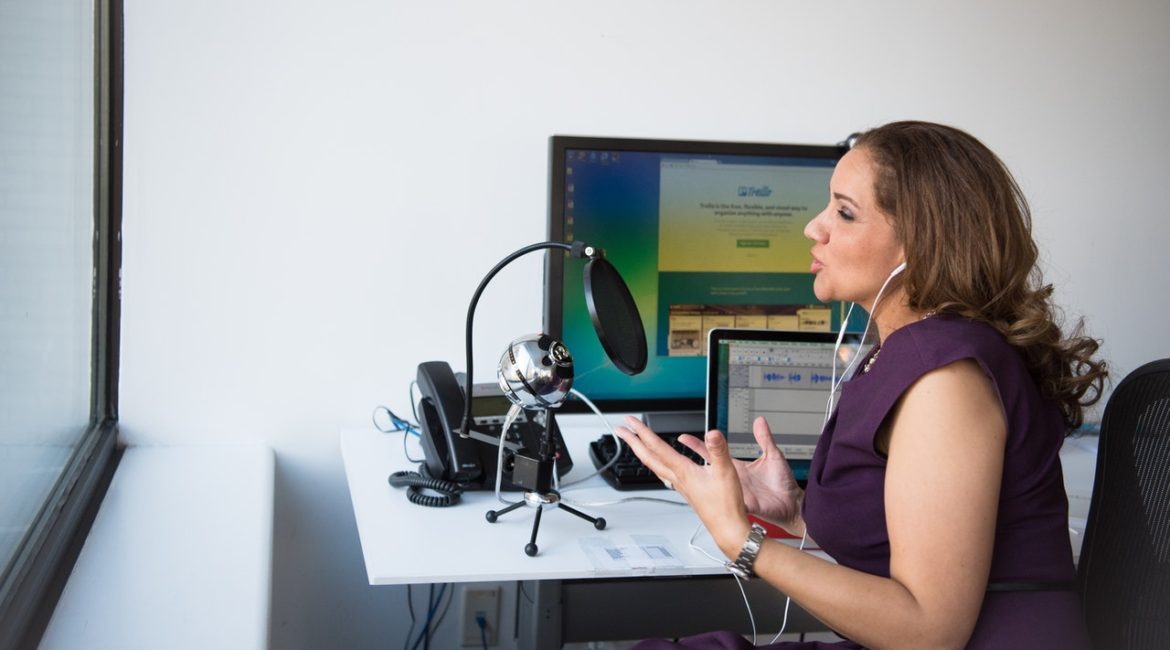2020 was the year of the video call, and by now many of us have a carved out a clutter-free radius in our living space so that we can take these meetings.

But when it comes to podcasting, where the audio and video files are being recorded and therefore will live eternally on the internet, it might be a good idea to invest a little more time and effort into your space so that you can deliver your message in a professional environment. No matter how engaging and interesting your content is, an unprofessional production will detract from your message and lose your audience’s attention. With that in mind, we’ve compiled some tips from our podcast engineer and production specialists so that nothing technical gets between you and your audience.
Lighting
Lighting is one of the first things that viewers will clock about your video, and sets their first impression of you and your content. If you test out different lighting setups before you begin recording, you’ll find that you can largely intuit what flatters you and your space the most. But to save you some time, here are our engineer’s home set-up lighting tips.
The main thing is to ensure that you are lit from the front. Unsurprisingly, the sun is one of our best sources of light available, and will make you look great on camera. If you have an externally facing window and there’s daylight available (morning and evening light is best), set yourself up so that your windows are in front of you, and you’re facing them.
If you’re filming at night or don’t have a window available, you can try to simulate this effect by placing a large lamp or two in front of your device. You’ll want to avoid overhead lighting at all costs, and try to avoid using one solitary lamp if possible. Overhead lighting and one light source can create shadows which will add a dramatic flair to your video and ultimately be very distracting to your viewers (it’s often the least flattering light, as well). When you’re checking your setup before hitting record, try to minimize any shadows in your video. Little to no shadows will create a more professional, open, and straightforward tone to your video. A good option to achieve flat light in your video is to place two light sources on either side of your device, and slightly behind it. If you only have one light source available, place it directly behind your device and have it shine on your face.
Camera Placement & Framing

Try to set your camera at eye level or higher. You can grab a box or stack some books to achieve the proper height. You definitely don’t want to have your camera tilted up at your face – if you’ve ever turned on your front-facing phone camera accidentally, you know that isn’t a flattering angle for anybody! Generally it’s best to include a little bit of your torso in the frame, from the middle of your chest up.
Spend some time adjusting the framing of your video. Our founding_media podcast engineer will provide feedback on ways to better frame yourself for your video, but if you’re going for it without our professional help, a good general rule of thumb is to follow the ‘rule of thirds’.
Imagine that a three-by-three grid is laid over your video. Rather than sitting directly in the center of this field, you’ll want to move to one of the lines of the grid. The points where the lines would intersect are where the eye naturally gravitates, so try to place yourself on those targets if possible.
Background
Avoid using background replacement softwares and green screening. These are distracting, and often seem unprofessional – although nothing is less professional than a messy, cluttered background. Take some time to prepare your background before you begin filming. No one expects you to go full creative director for every podcast, but cleaning up the area that is in frame, closing doors, and ensuring there are no personal items on the walls or shelves behind you is worth the fifteen minutes it will take.
Another option is to use a solid-colored background – a blank wall, a bedsheet (ironed or steamed so that there are no creases), or backdrop paper are good options. Check the backdrop and lighting combination before filming to ensure that no shadows are cast behind you.
Audio
While the elements we’ve discussed above are very important, poor audio quality is public enemy number one when it comes to podcasting. We recommend using headphones at a minimum, because it will minimize any echo from your mic picking up sound from your own speakers. If you are able to invest in a microphone, that is ideal. Really good models hover between the $100 and $200 price points, but there are solid options on the market for under $100 as well.

As much as you can, try to cut down on ambient noise. Don’t run the dishwasher, play music, or have the TV on in the background of your video. Let anyone else in your space know that you’re recording a podcast, and close all your windows before hitting record.
Presence
Beyond the technology, how you carry yourself can communicate professionalism or apathy. It takes practice to perfect your demeanor, but a good start is to be cognizant of your body language on a podcast. How you are sitting, what you are wearing , and how you are carrying yourself speaks volumes before you even open your mouth. Calm, open podcast hosts are comforting and inviting. Sit up straight to relay that you’re taking yourself and the podcast seriously. Don’t cross your arms, and keep your shoulders back and relaxed. Make an effort to actively listen to your guest, nodding and responding in other non-verbal ways. These things will automatically lend to an open, interested demeanor. And don’t forget to smile, especially to kick the episode off! You want your guests to know that you enjoy what you’re talking about.
Slow down when you’re speaking, and enunciate your words. If you’re feeling nervous, try to focus on your guest or the host… and remember to breathe! Finding your on-screen persona and becoming comfortable in the spotlight takes time, so don’t be afraid to practice a little beforehand.
We hope these tips will help you craft a professional, warm, and inviting environment for your podcast. For expert assistance in creating a podcast for your business, reach out to us at [email protected] – we are a full-service production company that can assist with storyboarding, recording, editing, and distribution. Check out our podcast network here!




